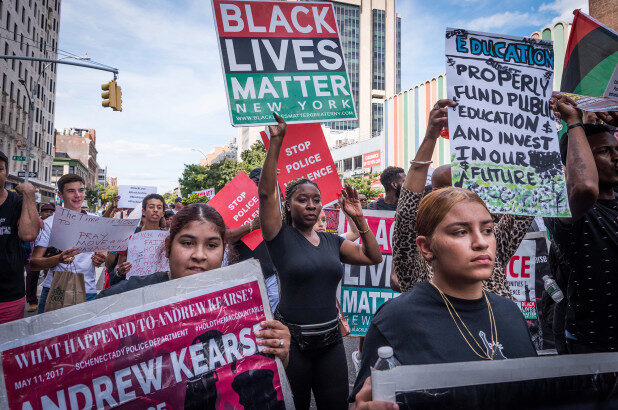The initiative began in Seattle, where teachers organized a "Black Lives Matter at School Day," in October, 2016. News of the event spread, and after the National Education Association adopted a resolution of endorsement, BLM at School Day became the BLM at School National Week of Action, to be held annually the first week of February to set the tone for Black History Month.
In 2018, school districts in more than 20 major cities, including New York, Philadelphia, Washington, DC, Boston, Chicago, Los Angeles and Seattle incorporated BLM at School Week into their curricula, and still more participated this year.
Incorporating BLM's ideas into K-12 school curricula extends beyond one week of each school year. In a letter of support, BLM co-founder Opel Tometi describes the effort as "a new uprising for racial justice" in the nation's schools.
The editors of Rethinking Schools, a trade publication dedicated to advancing the agenda of the social-justice left in classrooms, declare: "We need to transform our schools into sites of resistance to a system that devalues Black lives."
In the eyes of many well-intentioned teachers and parents, this is all to the good — and so it would be, if the design were to teach students, in a sensible way, the wrongfulness of racial discrimination. Regrettably, it isn't.
In the introduction to Teaching for Black Lives, a recently published textbook meant to accompany BLM's classroom efforts, the first sentence reads: "Black students' minds and bodies are under attack."
The stoking of students' fear and anger continues with a reference to "the continuing police murders of black people," along with this characterization of the galvanizing event for BLM's street protests:
"In August of 2014, Michael Brown was killed in the streets of Ferguson, Missouri, his body left in the streets for hours as a reminder to the black residents in the neighborhood that their lives are meaningless to the American Empire."Students who desire balanced discussions of the complex matter of race relations in the United States should look elsewhere. In the BLM-inspired classroom, students will be catechized to deplore "the school-to-prison pipeline" and the "epidemic of police violence and mass incarceration" in America.
They won't be encouraged to inquire critically about the absolute numbers of shootings by police in recent years, as compared to the numbers of shootings by criminal perpetrators; nor about how many of those shot by police were violently resisting arrest; nor about differential rates of serious crime among various racial or ethnic groups; nor about the effects of relaxed disciplinary policies on classroom order and learning opportunities for the non-disruptive majority of students, especially in schools serving predominantly disadvantaged populations; nor, finally, about a host of other questions discomforting to BLM's radical visionaries.
The dogmatism is itself deplorable, but what is worst of all in the BLM pedagogy is the demoralizing effect likely to ensue from it. What are young students of color to infer from the teaching that they are subjects of a pervasive, racialized despotism?
What BLM's pedagogues want them to infer is that resistance is the one thing needful — that their proper models are the leaders of racial protest, the more radical the better. Yet on BLM's own story, after more than 200 years of such protest, an apparently indestructible system of structural racism endures. What students are left with is a doctrine of utter futility and hopelessness.
This teaching is both false and grossly irresponsible. Racism's wisest adversaries have always insisted, often under far more trying conditions than what prevails today, that in America there is always cause for hopefulness, and the key to liberty and happiness lies not in perpetuated opposition but in cultivating the virtues of mind, heart and character.
That, and not BLM's ideological fatalism, is the teaching that should be spreading throughout America's schools.
Peter Myers is a professor of political science at University of Wisconsin, Eau Claire. This essay was adapted from City Journal.




Reality derangement syndrome strikes again.